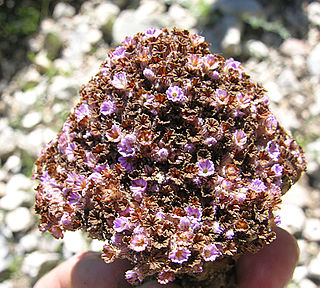
Edward Tuckerman was an American botanist and professor who made significant contributions to the study of lichens and other alpine plants. He was a founding member of the Natural History Society of Boston and most of his career was spent at Amherst College. He did the majority of his collecting on the slopes of Mount Washington in the White Mountains of New Hampshire. Tuckerman Ravine was named in his honor. The standard botanical author abbreviation Tuck. is applied to species he described.
PlowmanianthusFaden & C.R.Hardy is a genus of plants with 5 species and 2 subspecies in the family Commelinaceae. The genus is distributed from Panama to Amazonian Peru and Brazil.
Thomas Gordon Hartley was an American botanist.

Weldenia is a monotypic genus of flowering plants in the family Commelinaceae, first formally described in 1829. It has one single species: Weldenia candida, which grows natively in Mexico and Guatemala.
Timothy Charles Plowman was an ethnobotanist best known for his intensive work over the course of 15 years on the genus Erythroxylum in general, and the cultivated coca species in particular. He collected more than 700 specimens from South America, housed in the collection of the Field Museum of Natural History. The standard author abbreviation Plowman is used to indicate this person as the author when citing a botanical name.
Agiortia is a small genus of flowering plants in the family Ericaceae.
Mortoniella is a monotypic genus of flowering plants in the family Apocynaceae, first described as a genus in 1939. It contains only one known species, Mortoniella pittieri, native to Central America.
Maxwellia lepidota is a species of shrubs or trees in the family Malvaceae. It is endemic to New Caledonia and the only species of the monotypic genus Maxwellia. Its closest relatives are all Australian genera in tribe Lasiopetaleae: Guichenotia, Hannafordia, Lysiosepalum, Lasiopetalum and Thomasia.

Prockia is a genus of flowering plants in the family Salicaceae. It consists of approximately six species of shrubs and small trees native to the West Indies, Mexico, Central America, and South America. Its type species, Prockia crucis, is highly polymorphic and has a broad distribution, from Mexico and the West Indies to Uruguay and northern Argentina.
Verhuellia is a genus of flowering plants belonging to the family Piperaceae. Verhuellia is a sister genus to all other Piperaceae, but has its own subfamily of Verhuellioideae.
Torralbasia is a monotypic genus of flowering plants belonging to the family Celastraceae. It only contains the one known species, Torralbasia cuneifolia(C.Wright ex A.Gray) Krug & Urb.

Lennoa is a monotypic genus of flowering plants belonging to the family Boraginaceae. It only contains one known species, Lennoa madreporoidesLex. It is within the subfamily of Lennoaceae.
Siemensia is a monotypic genus of flowering plants belonging to the family Rubiaceae. It only contains one known species, Siemensia pendula(C.Wright ex Griseb.) Urb.
Koyamaea is a monotypic genus of flowering plants belonging to the family Cyperaceae. The only species is Koyamaea neblinensisW.W.Thomas & G.Davidse.

Metternichia is a genus of flowering plants belonging to the family Solanaceae. For a long time he only species was Metternichia principisJ.C.Mikan., but recently a second species, M. macrocalyx (Carvalho)L.S.de Souza was recognised

Nepsera is a monotypic genus of flowering plants belonging to the family Melastomataceae. The only species is Nepsera aquatica.
Oserya is a genus of flowering plants belonging to the family Podostemaceae. Its native range is northern South America, and it is found in Bolivia, Brazil, French Guiana, Guyana, Suriname and Venezuela.
Poupartiopsis is a monotypic genus of flowering plants belonging to the family Anacardiaceae. The only species is Poupartiopsis spondiocarpus.

Gaya is a genus of flowering plants belonging to the family Malvaceae. It has been classed in the Malvoideae subfamily and the Malveae tribe.






